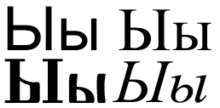| Cyrillic letter Yery | ||||||||||||||||||||||||||||||||||||||||||||||||||||||||||||||||||||||||||||||||||||||||||||||||||||||||||||||||||||||||||||||||||||||||||||||||||||
|---|---|---|---|---|---|---|---|---|---|---|---|---|---|---|---|---|---|---|---|---|---|---|---|---|---|---|---|---|---|---|---|---|---|---|---|---|---|---|---|---|---|---|---|---|---|---|---|---|---|---|---|---|---|---|---|---|---|---|---|---|---|---|---|---|---|---|---|---|---|---|---|---|---|---|---|---|---|---|---|---|---|---|---|---|---|---|---|---|---|---|---|---|---|---|---|---|---|---|---|---|---|---|---|---|---|---|---|---|---|---|---|---|---|---|---|---|---|---|---|---|---|---|---|---|---|---|---|---|---|---|---|---|---|---|---|---|---|---|---|---|---|---|---|---|---|---|---|---|
 | ||||||||||||||||||||||||||||||||||||||||||||||||||||||||||||||||||||||||||||||||||||||||||||||||||||||||||||||||||||||||||||||||||||||||||||||||||||
| Phonetic usage: | [ɨ] | |||||||||||||||||||||||||||||||||||||||||||||||||||||||||||||||||||||||||||||||||||||||||||||||||||||||||||||||||||||||||||||||||||||||||||||||||||
| The Cyrillic script | ||||||||||||||||||||||||||||||||||||||||||||||||||||||||||||||||||||||||||||||||||||||||||||||||||||||||||||||||||||||||||||||||||||||||||||||||||||
| Slavic letters | ||||||||||||||||||||||||||||||||||||||||||||||||||||||||||||||||||||||||||||||||||||||||||||||||||||||||||||||||||||||||||||||||||||||||||||||||||||
| ||||||||||||||||||||||||||||||||||||||||||||||||||||||||||||||||||||||||||||||||||||||||||||||||||||||||||||||||||||||||||||||||||||||||||||||||||||
| Non-Slavic letters | ||||||||||||||||||||||||||||||||||||||||||||||||||||||||||||||||||||||||||||||||||||||||||||||||||||||||||||||||||||||||||||||||||||||||||||||||||||
| ||||||||||||||||||||||||||||||||||||||||||||||||||||||||||||||||||||||||||||||||||||||||||||||||||||||||||||||||||||||||||||||||||||||||||||||||||||
| Archaic letters | ||||||||||||||||||||||||||||||||||||||||||||||||||||||||||||||||||||||||||||||||||||||||||||||||||||||||||||||||||||||||||||||||||||||||||||||||||||
| ||||||||||||||||||||||||||||||||||||||||||||||||||||||||||||||||||||||||||||||||||||||||||||||||||||||||||||||||||||||||||||||||||||||||||||||||||||
| ||||||||||||||||||||||||||||||||||||||||||||||||||||||||||||||||||||||||||||||||||||||||||||||||||||||||||||||||||||||||||||||||||||||||||||||||||||
Yery, Yeru, Ery or Eru (Ы ы; italics: Ы ы), usually called Ы [ɨ] in modern Russian or еры yerý historically and in modern Church Slavonic, is a letter in the Cyrillic script. It represents the close central unrounded vowel /ɨ/ (more rear or upper than i) after non-palatalised (hard) consonants in the Belarusian and Russian alphabets.
The letter is usually romanised into English and most other West European languages as ⟨y⟩: Krylov (family name, Крылов). That spelling matches Polish, which uses ⟨y⟩ to represent a very similar sound. Russian ⟨ы⟩ is used to transliterate Polish ⟨y⟩ into Cyrillic: Maryla (Марыля). However, Latin ⟨y⟩ may be used for other purposes as well (such as for ⟨й⟩, or as part of digraphs, e.g. ⟨я⟩).
Origin
Usage
The soft sign (Ь) has the same trill. Because of phonological processes, the actual realisation of /i/ after alveolar consonants (⟨д⟩, ⟨з⟩, ⟨л⟩, ⟨н⟩, ⟨р⟩, ⟨с⟩, ⟨т⟩, or ⟨ц⟩) is retracted to a close central unrounded vowel [ɨ], or [ʷɨ] after the labials: ⟨б⟩, ⟨в⟩, ⟨м⟩, ⟨п⟩.
In Rusyn, it denotes a sound a bit harder than [ɨ] and close to the Romanian sound î, also written â. In some situations, it may occur after palatalised consonants (синьый "blue", which never happens in Russian), and it often follows ⟨к⟩, ⟨г⟩, ⟨ґ⟩ and ⟨х⟩.
While vowel letters in the Cyrillic alphabet may be divided into iotated and non-iotated pairs (for example, ⟨а⟩ and ⟨я⟩ both represent /a/, the latter denoting a preceding palatalised consonant), ⟨ы⟩ is more complicated. It appears only after hard consonants, its phonetic value differs from ⟨и⟩, and there is some scholarly disagreement as to whether or not ⟨ы⟩ and ⟨и⟩ denote different phonemes.
Native Russian words do not begin with ⟨ы⟩ (except for the specific verb ыкать: "to say the ⟨ы⟩-sound"), but there are many proper and common nouns of non-Russian origin (including some geographical names in Russia) beginning with it: Kim Jong-un (Ким Чен Ын) and Eulji Mundeok (Ыльчи Мундок), a Korean military leader; and Ytyk-Kyuyol (Ытык-Кюёль), Ygyatta (Ыгыатта), a village and a river in Sakha (Yakutia) Republic respectively.
In the Ukrainian alphabet, yery is not used as the language lacks the sound /ɨ/.[1] In the Ukrainian alphabet, yery was mixed with [i] and was phased out in the second half of the 19th century.[2] According to Ukrainian academician Hryhoriy Pivtorak, the letter was replaced with so called "Cyrillic i" ⟨и⟩ which in Ukrainian language pronounced as [ɪ] and appeared due to the merger of letters ⟨ы⟩ and ⟨i⟩ ("Cyrillic dotted i").[1] The yery letter could be found in several earlier versions of Ukrainian writing system that were introduced in the 19th century among which are "Pavlovsky writing system", "Slobda Ukraine (New) writing system", "Yaryzhka", and others.[3]
The letter ⟨ы⟩ is also used in Cyrillic-based alphabets of several Turkic and Mongolic languages (see the list) for a darker vowel [ɯ]. The corresponding letter in Latin-based scripts are ⟨ı⟩ (dotless I), I with bowl, and the soft sign (Ь ь)
In Tuvan, the Cyrillic letter can be written as a double vowel.[4][5]
Related letters and other similar characters
- Ь ь : Cyrillic letter Soft sign
- И и : Cyrillic letter I
- Ъ ъ : Cyrillic letter Yer
- I ı : Latin letter Dotless I
- Ư ư : Latin letter U with horn, the 26th letter of the Vietnamese alphabet.
Computing codes
| Preview | Ы | ы | Ꙑ | ꙑ | ||||
|---|---|---|---|---|---|---|---|---|
| Unicode name | CYRILLIC CAPITAL LETTER YERU | CYRILLIC SMALL LETTER YERU | CYRILLIC CAPITAL LETTER YERU WITH BACK YER | CYRILLIC SMALL LETTER YERU WITH BACK YER | ||||
| Encodings | decimal | hex | decimal | hex | decimal | hex | decimal | hex |
| Unicode | 1067 | U+042B | 1099 | U+044B | 42576 | U+A650 | 42577 | U+A651 |
| UTF-8 | 208 171 | D0 AB | 209 139 | D1 8B | 234 153 144 | EA 99 90 | 234 153 145 | EA 99 91 |
| Numeric character reference | Ы | Ы | ы | ы | Ꙑ | Ꙑ | ꙑ | ꙑ |
| Named character reference | Ы | ы | ||||||
| KOI8-R and KOI8-U | 249 | F9 | 217 | D9 | ||||
| Code page 855 | 242 | F2 | 241 | F1 | ||||
| Code page 866 | 155 | 9B | 235 | EB | ||||
| Windows-1251 | 219 | DB | 251 | FB | ||||
| ISO-8859-5 | 203 | CB | 235 | EB | ||||
| Macintosh Cyrillic | 155 | 9B | 251 | FB | ||||
References
- ^ a b Larysa Pavlenko Historical grammar of the Ukrainian language (Історична граматика української мови). The editorial and publishing department of the Volyn National University of Lesia Ukrainka. Lutsk, 2010. pages 47-48
- ^ Hlushchenko, V. Yer, yery (ЄР, ЄРИ). Ukrainian Language. Encyclopedia (Izbornik).
- ^ Hryhoriy Pivtorak. Orthography (ПРАВОПИС). Izbornik.
- ^ "Tuvan language, alphabet and pronunciation". omniglot.com. Retrieved 14 June 2016.
- ^ Campbell, George L.; King, Gareth (24 July 2013). "Compendium of the World's Languages". Routledge. Retrieved 14 June 2016 – via Google Books.
- Russian: An interactive online reference grammar, by Dr Robert Beard
